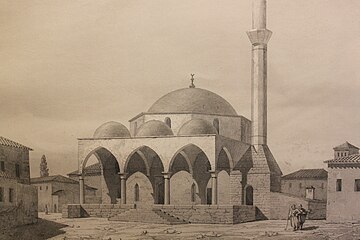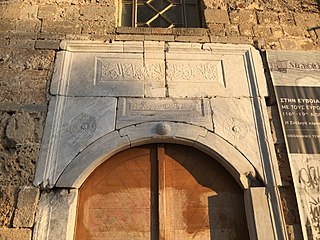Emir Zade Mosque
The Emir Zade Mosque (Greek: Εμίρ Ζαδέ Τζαμί, from Turkish: Emirzade Camii, lit. 'Mosque of the Emir’s son') is a historical Ottoman-era mosque in the town of Chalcis, on the island of Euboea, Greece. It is now a museum non-accessible to the public.
History
The mosque was built shortly after the fall of Euboea to the Ottomans in the 15th century, and it was one of the three mosques within the walled city.[1] Evliya Çelebi, an Ottoman explorer and traveller, visiting Chalcis in the 17th century, noted eleven mosques including Emir Zade.[2]
The minaret and portico survived intact until around the mid-19th century, based on a watercolor picture by Andre Couchaud in 1843.[2]
Following the Greek War of Independence in 1821 and the liberation of Chalcis from the Ottoman Turks, it was converted into a barracks.[1] In 1937 it was declared a historical monument, and today it houses part of the medieval archaeological collection of Chalcis, however the museum is not open to the public.[1] Since the late 1950s the building has been gradually restored while in the period 1970 to 1973 period it underwent restoration work.[2]
Architecture
Outside the Ottoman mosque there are remains of an earlier Christian church which was converted into a mosque.[2] The Emir Zade Mosque is of a simple architectural style of single-dome mosque, like most in Greece and the rest of the Balkans.[2]
Aside from the lost portico and minaret, the mosque survives almost intact. It consists of a rectangular room covered by a dome which is hemispherical inside and octagonal outside, resting on four semi-conical domes. On the west side there by columns gallery, the revak, roofed with hemispherical calotte. The cylindrical minaret used to stand on the sourthwest side; only the square base is left.[2]
The marble slabs of the entrance frame have inscriptions in Arabic, which read “enter here in peace and will be immortal in the name of all-merciful God.” The interior of the mosque is illuminated by two parallel rows of windows. Inside, the niche of the mihrab was placed in the east wall, where traces of colour and the original décor still remain. Two more marble plaques inscribed with excerpts from the Quran in Arabic crown the arch.[2] Preserved is also the fountain in the yard, bearing inscriptions and decorated with elaborately embossed Arabic art,[2] built in 1655.[1] Scattered around the mosque are several fragments of ancient columns and capitals.[1]
Civil engineer, Giannis Karalis, made the following observation: "The Emir Zade mosque–like several of those preserved in Greece–is of particular interest due to its relationship with Byzantine architecture, by which it was clearly influenced, as well as its integration into the medieval Greek settlements. The study, however, has not yet progressed."[1]
Gallery
- Emir Zade Mosque
-
 Gravure by Antoine-Marie Chenavard in 1858.
Gravure by Antoine-Marie Chenavard in 1858. -
 View of the fountain and the mosque from the north.
View of the fountain and the mosque from the north. -
 The main façade principale.
The main façade principale. -
 Detail of the dedicatory inscription.
Detail of the dedicatory inscription. -
 View of the mihrab.
View of the mihrab.
See also
References
- ^ a b c d e f "Τζαμί Εμίρ Ζαδέ στη Χαλκίδα" [Emir Zade Mosque in Chalcis]. eviaportal.gr. March 9, 2014. Retrieved October 7, 2022.
- ^ a b c d e f g h "The Ottoman mosque Emir Zade". eviagreece.gr. Retrieved October 7, 2022.
External links
 Media related to Emir Zade Mosque at Wikimedia Commons
Media related to Emir Zade Mosque at Wikimedia Commons
- v
- t
- e
- Bab Gedid Mosque
- Bayrakli Mosque
- Defterdar Mosque
- Enderum Mosque1
- Gazi Hasan Pasha Mosque, Loggia
- Gazi Hasan Pasha Mosque, Platani
- Hamza Bey Mosque
- Ibrahim Pasha Mosque
- Kavaklı Mosque1
- Kavos Mosque
- Khan Zade Mescidi1
- Mecidiye Mosque
- Mehmet Agha Mosque
- Murat Reis Mosque
- Mustafa Pasha Mosque
- Osmaniye Mosque
- Recep Pasha Mosque
- Suleymaniye Mosque
- Valide Mosque
- Yeni Mosque


- Emir Zade Mosque
- Fethiye Mosque, Athens
- Fethiye Mosque, Nafpaktos
- Gazi Omer Bey Mosque
- Parthenon1
- Parthenon mosque
- Tzistarakis Mosque
- Vizier Mosque
- Votanikos Mosque
- Aslan Pasha Mosque
- Faik Pasha Mosque
- Fethiye Mosque
- Feyzullah Mosque
- Kaloutsiani Mosque
- Rokka Mosque
- Sultan Mehmed Mosque
- Veli Pasha Mosque
- Ahmed Bey Mosque
- Alaca Imaret Mosque
- Arap Mosque
- Ayasofya Mosque1
- Bey Mosque1
- Eski Mosque1
- Halil Bey Mosque
- Hamza Bey Mosque
- Hünkar Mosque1
- Ibrahim Pasha Mosque
- İki Şerefiye Mosque1
- İshakiye Mosque1
- Iskender Bey Mosque
- Kasımiye Mosque1
- Kazancilar Mosque1
- Koca Mustafa Mosque
- Kursum Mosque
- Lembet Mosque
- Mahmud Çelebi Mosque
- Mehmet Bey Mosque
- Medrese Mosque
- Muhammad Ali Pasha Mosque
- Orta Mosque
- Saraylı Mosque1
- Soğuksu Mosque1
- Soluca Mosque1
- Suleyman Hortaci Effendi Mosque1
- Yakup Bey Mosque
- Yakup Pasha Mosque1
- Yeni Mosque, Edessa
- Yeni Mosque, Thessaloniki
- Zincirli Mosque
- Bold are open for worship.
- 1 Converted church or temple.
- Islam in Greece
- Former mosques

















